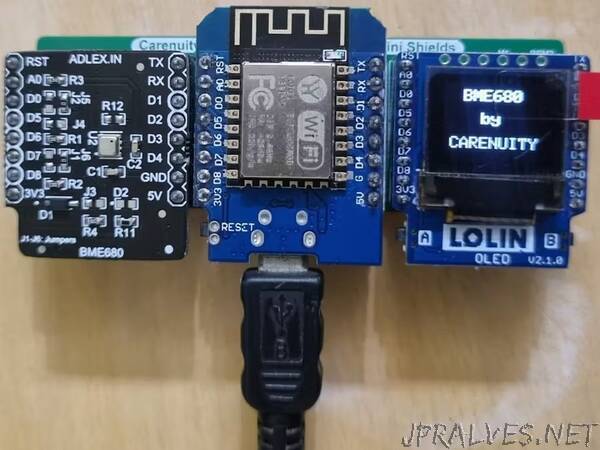
“Design and Implementation of an Environmental Sensor with Integrated BME680 for Multi-Parameter Measurements.
In this project, we will create a Environmental sensor using BME680 which can measure Temperature, Humidity, Altitude, Pressure & Gas resistance value. We use ESP 8266 D1 Mini as microcontroller along with a 0.66 inch OLED display to visualize the data comming form the sensor. We use a tripple adaptor as the PCB to connect all three hardwares (ESP8266 D1 Mini, BME680, 0.66 inch OLED Display) together (all hardware details are mention).
Abstract
This project focuses on the development of an environmental sensor leveraging the BME680 sensor module to measure a comprehensive set of parameters including Temperature, Humidity, Altitude, Pressure, and Gas Resistance. The core components of the system comprise an ESP8266 D1 Mini microcontroller and a 0.66-inch OLED display for real-time data visualization.
A key feature of this project is the utilization of a triple adaptor printed circuit board (PCB) design to seamlessly integrate the ESP8266 D1 Mini, BME680 sensor, and the OLED display. This approach enhances the modularity and connectivity of the system, allowing for efficient communication and collaboration between the hardware components.
The resulting environmental sensor promises versatility and accuracy in monitoring various environmental conditions. The integrated OLED display provides a user-friendly interface for real-time data presentation, offering a practical solution for applications ranging from home automation to industrial monitoring.
Project Overview
This project consist of two different parts.1. Hardware setup.2. Firmware development.
Features of BME680
The BME680 is a versatile environmental sensor developed by Bosch Sensortec, known for its ability to measure multiple environmental parameters. Some of its notable features include:
Multi-Parameter Measurement:
- The BME680 is capable of measuring various environmental parameters, including Temperature, Humidity, Pressure, and Gas Resistance. This makes it a comprehensive solution for environmental sensing applications.
Gas Sensing:
- One distinctive feature of the BME680 is its ability to measure gas resistance. This is particularly useful for monitoring indoor air quality, detecting volatile organic compounds (VOCs), and providing insights into the composition of the surrounding atmosphere.
High Accuracy:
- The sensor is designed to provide accurate and reliable measurements, making it suitable for applications where precision is crucial, such as weather stations, environmental monitoring systems, and indoor air quality monitoring.
Temperature Compensation:
- The BME680 incorporates temperature compensation mechanisms, ensuring that environmental measurements remain accurate even in varying temperature conditions. This feature enhances the sensor’s performance and reliability.
Altitude Measurement:
- In addition to basic environmental parameters, the BME680 includes an altimeter function, enabling it to measure changes in altitude. This is valuable for applications such as outdoor activity tracking and navigation.
Low Power Consumption:
- The sensor is designed with low power consumption in mind, making it suitable for battery-powered devices and applications where energy efficiency is a priority.
I2C and SPI Communication:
- The BME680 supports both I2C (Inter-Integrated Circuit) and SPI (Serial Peripheral Interface) communication protocols, providing flexibility in interfacing with various microcontrollers and systems.
Compact Design:
- The sensor is typically compact and lightweight, making it suitable for integration into small devices and systems with limited space.
Extended Operating Temperature Range:
- The BME680 is designed to operate effectively across a wide temperature range, expanding its usability in diverse environmental conditions.
Extended Operating Temperature Range:The BME680 is designed to operate effectively across a wide temperature range, expanding its usability in diverse environmental conditions.
Integrated Heater:
- The sensor includes an integrated heater that can be utilized to improve the accuracy of gas measurements by facilitating the release of previously adsorbed gases from the sensing elements.
These features collectively make the BME680 a versatile and powerful tool for environmental sensing applications, offering a comprehensive set of measurements in a compact and energy-efficient package.
Tripple Adaptor
The Triple Adaptor is an innovative printed circuit board (PCB) designed to seamlessly integrate and interconnect three distinct hardware components. At its core, this PCB features three identical slots, each tailored to accommodate various hardware modules while maintaining a uniform package size. What sets the Triple Adaptor apart is the intelligent design that ensures all three slots are intricately connected to one another, establishing a common connectivity framework.
The layout of the Triple Adaptor is carefully crafted to facilitate the simultaneous connection of diverse hardware components, making it a versatile solution for various electronic projects. The unified design enables efficient communication and data exchange between the connected devices, creating a cohesive and streamlined system.
In a practical example of the Triple Adaptor’s capabilities, the user can integrate an ESP 8266 D1 Mini, a compact yet powerful microcontroller, into one of the slots. Simultaneously, a 0.66-inch OLED display can be seamlessly added to another slot, offering a visual interface for real-time data presentation. Additionally, a BME680 sensor, renowned for its accuracy in measuring environmental parameters, can be effortlessly incorporated into the third slot. The brilliance of the Triple Adaptor lies in its ability to unite these disparate hardware components within a single interconnected system.
The common connectivity provided by the Triple Adaptor promotes synergy among the connected devices, fostering collaboration and enhancing the overall functionality of the integrated system. This unique PCB serves as a central hub, allowing data to flow seamlessly between the ESP 8266 D1 Mini, OLED display, and BME680 sensor. This capability opens up a myriad of possibilities for applications in home automation, IoT projects, or any scenario where multiple hardware components need to work in harmony.
In summary, the Triple Adaptor is not just a PCB with three slots; it is a sophisticated solution that bridges the gap between different hardware modules, fostering connectivity and collaboration in electronic projects. Its design excellence and versatile functionality make it a standout choice for enthusiasts and professionals alike seeking a unified platform for integrating diverse hardware components.”
